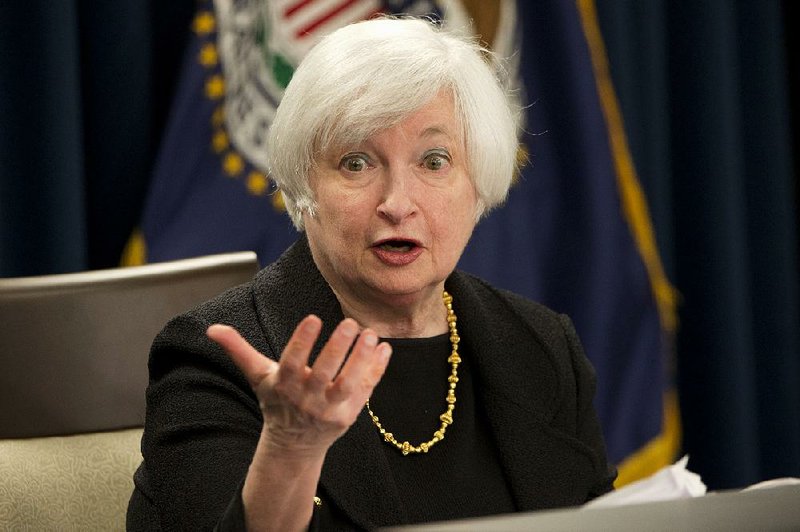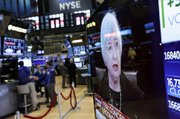WASHINGTON -- The Federal Reserve decided Thursday to keep U.S. interest rates at record lows in the face of threats from a weak global economy, persistently low inflation and unstable financial markets.
While the U.S. job market is solid, global pressures may "restrain economic activity" and further drag down already low inflation, the Fed said Thursday in a statement after ending a policy meeting.
Signs of an economic slowdown in China and other emerging economies have intensified fears among investors about the U.S. and global economy. And low oil prices and a high-priced dollar have kept inflation undesirably low.
The Fed's announcement ended weeks of speculation about whether it might finally be ready to raise rates from the record lows it first set at the depths of the 2008 financial crisis. The low loan rates the Fed engineered were intended to help the economy recover from the recession. Since then, the economy has nearly recovered even as pressures from abroad appear to have grown.
On the crowded trading floor at Raymond James and Associates Inc. on Park Avenue in New York, the reaction to the most anticipated Fed Open Market Committee meeting in recent memory was an astonished "Wow" from one man in a crisp blue-striped shirt.
Whether traders were betting that the Fed would act or not, they just wanted the wait to be over. The last time the target rate was raised was in June 2006, and since December 2008 it's been near zero. The government stimulus that started after the financial crisis as a boon to equity markets turned to a burden in recent months as a lack of clarity on the Fed's plan loomed over stocks.
"I feel deflated," said Mark Koczan, a trader at Raymond James. "It's just more kicking the can down the road."
At a news conference, Fed Chairman Janet Yellen said a rate increase is still likely this year. Most of the Fed officials on the committee that sets the federal funds rate, which controls the interest that banks charge one another, still foresee higher rates before next year. The Fed will meet next in October and then in December.
"Every [Fed] meeting is a live meeting," Yellen said. "October, it remains a possibility."
In their statement, Fed officials stressed that they were "monitoring developments abroad" and that the global slowdown might restrain U.S. economic growth and inflation levels. This appeared to be a reference to China, the world's second-largest economy.
China's economy has slowed for four straight years -- from a government-reported 10.6 percent in 2010 to 7.4 percent last year. The International Monetary Fund expects the Chinese economy to grow just 6.8 percent this year, the slowest since 1990.
"The case for not going is that the inflation picture is still extremely murky, especially in light of developments in China," Ward McCarthy, chief financial economist at Jefferies LLC in New York, said before the decision.
Changes in the federal funds rate are the Fed's primary lever for influencing the economy. The benchmark rate directly influences other short-term rates, such as the prime rate and credit card rates.
However, the Fed's bigger influence on the economy flows from its monetary policy's effects on long-term borrowing costs, such as rates on mortgages and corporate debt. Those interest rates affect the prices of stocks, bonds, real estate and other assets. Long-term rates are based on financial markets' expectations of the path of short-term rates over time.
Fed officials have made clear that they are not inclined to wait much longer. Monetary policy exerts a gradual influence on economic conditions, and its major effects often take many months to kick in. Stanley Fischer, the Fed's vice chairman, warned in late August that officials would not be able to postpone a decision until all of their doubts were resolved.
"When the case is overwhelming," he said, "if you wait that long, then you've waited too long."
Even after the first increase off of zero, Fed interest rate policy will be "highly accommodative for quite some time," Yellen said.
Wall Street's early reaction to the Fed's decision, which investors had widely expected, was muted. U.S. stocks ended mostly lower Thursday. The Dow Jones industrial average dropped 65 points, or 0.4 percent, to 16,674.74.
Bond investors seemed cheered by the Fed's decision to keep rates very low. The yield on the 10-year Treasury note fell to 2.23 percent from 2.30 percent late Wednesday. Bond prices tend to rise and yields tend to fall when investors expect subdued inflation, low rates and modest economic growth.
The Fed's action Thursday was approved in a 9-1 vote, with Jeffrey Lacker casting the first dissenting vote this year. Lacker, president of the Fed's Atlanta regional bank, had pushed for the Fed to begin raising rates by moving the federal funds rate up by a quarter-point.
Instead, the Fed retained language it has been using that it will be appropriate to raise interest rates when it sees "some further improvement in the labor market" and is "reasonably confident" that inflation will move back to the Fed's optimal inflation target of 2 percent.
The Fed's preferred measure of inflation was up just 1.2 percent in the latest reading and has been below 2 percent for more than three years.
In an updated economic forecast, 13 of the 17 Fed policymakers said they see the first rate increase occurring this year. In June, 15 Fed officials had predicted that the first rate change would occur this year.
The forecast also reduced the number of rate increases this year to show an expectation of just one quarter-point increase, rather than the two that had been the expectation at the June meeting.
The new forecast significantly lowered the expectation for inflation this year to show the Fed's preferred inflation gauge rising just 0.4 percent, down from a 0.7 percent forecast in June. The change takes into account the further rise in the value of the dollar, which makes imports cheaper, and a recent drop in oil prices. The Fed's forecast still foresees inflation accelerating to a 1.7 percent increase next year, still below its 2 percent target.
The new forecast has unemployment dropping to 5 percent by the end of this year, down from 5.3 percent in June. The unemployment rate in August dropped to a seven-year low of 5.1 percent.
Before Thursday's decision, some economists argued that many factors -- from a sharply slowing China to the tumult in markets to persistently less-than-optimal inflation -- raised concerns about a rate increase. Others contended that with the U.S. job market considered essentially recovered from the recession, it was time to start edging toward normal rates.
"Discretion is the better part of valor," Ethan Harris, co-head of global economic research at Bank of America Corp. in New York, wrote in an email. The move is a "tactical delay" to gather more information on risks to the forecast, and "as the labor market recovery rolls along, and with capital markets already showing signs of calm, the pressure on the Fed to hike will build at each meeting going forward."
Information for this article was contributed by Martin Crutsinger, Paul Wiseman and Ken Sweet of The Associated Press; by Kate Garber, Dani Burger and Craig Torres of Bloomberg News; and by Binyamin Appelbaum of The New York Times.
Business on 09/18/2015

